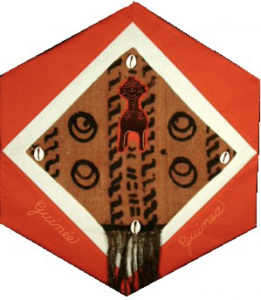Guinea

The Block
The Guinea block, designed by Soloba Sako and Kaba Hawa Diakite, was created from a piece of mud-cloth (bògòlanfini or Bökhölan,) a long-standing, traditional textile in Africa. This unique product begins with men weaving long strips of cotton cloth (finimugu) that are sewn together into panels. Once the cloth is prepared, women hand-paint designs onto it using a mud solution, a task that takes weeks to complete. Patterns, handed down from generation to generation, have specific names and all have significant in meaning. The central figure on this block is a Nimba, a national symbol that embodies both the Nimba Mountain and encapsulates the concept of fertility for both women and the fields. Nimba stands for strength, the joy of living, love of beauty and the connection to traditional customs. The circles in this design, and the cowrie shells sewn to each corner, represent the four major topographic regions of Guinea. Cowrie shells are important both decoratively (on calabashes, bracelets and earrings) and commercially (on the country’s paper money). Fringes, similar to the one in the bottom corner, are often used as a finishing touch on Guinean clothing.
Cultural Profile
Guinea, often referred to as “the Promised Land of Africa,” is also known as West Africa’s “water reservoir” since its Fouta Djalon mountain range is the source of, and feeds, an extraordinary number of rivers, amongst them the Niger, the Gambia and the Senegal rivers. Predominantly agricultural, Guinea is also home to approximately one-third of the world’s high-grade bauxite ore reserves, as well as large gold and oil reserves. The official language is French and the country’s diverse ethnic groups include the Fulani, the Mandinka (Mandingo or Malinke,) and the Susu. Guineans have a strong sense of community and are very supportive of one another. When greeting friends or strangers, Guineans feel it is important to ask them how they are before beginning a conversation, and to use formal titles such as Monsieur or Madame.
Guineans are renowned for their artistic and cultural diversity, exemplified in songs, dances and traditions. The djeli, or griot, a historian, storyteller, poet and musician is central to the transmission of songs and musical knowledge in the country. The knowledge of djelis is usually transmitted from father to son, which allows the apprentice many years to master instruments such as the traditional kora, a 21-string lut-harp hybrid made out of a hollowed calabash. Another traditional instrument is the balafon, an instrument similar to a xylophone where dried gourds are used as resonators for the wooden keys. The village of Nyagassola, in Guinea, is home to the 800 years old Sosso bala, said to be the original balafon. All other balafons made are to be tuned to the Sosso bala. The bolon is a traditional bass instrument used in Guinea, while the stringed ngoni is said to have evolved into the banjo after Mande people were brought over to North America. Guineans’ creative accomplishments in modern dance and popular music have given their musicians and singers an international reputation. Their national dance company, Les Ballets Africains, blends traditional dance, music and storytelling with acrobatics, comedy and drama, and has toured the world for over fifty years.
Guineans are also known for their leatherwork, wood-carvings, alluvial gold jewelry and textiles. Cotton is hand woven into thin strips and painted to produce the mud cloth or made into fabric and tie-dyed to produce colourful prints. Indigo, a plant widely grown in the country, is used for indigo cloth. The Fula people also use the pigment for markings around the mouth.
Immigration records indicate that Guineans have been coming to Canada since 1974, often settling in Québec for language reasons. As of 2011, there were 4,800 people of Guinean ancestry in Canada. Although comprising only a small percentage of the Canadian population, their influence can be heard in the music shared coast-to-coast by such artists as Alpha Yaya Diallo and Lilison Cordeiro.
Sponsor: Rotary Club of Cornwall
